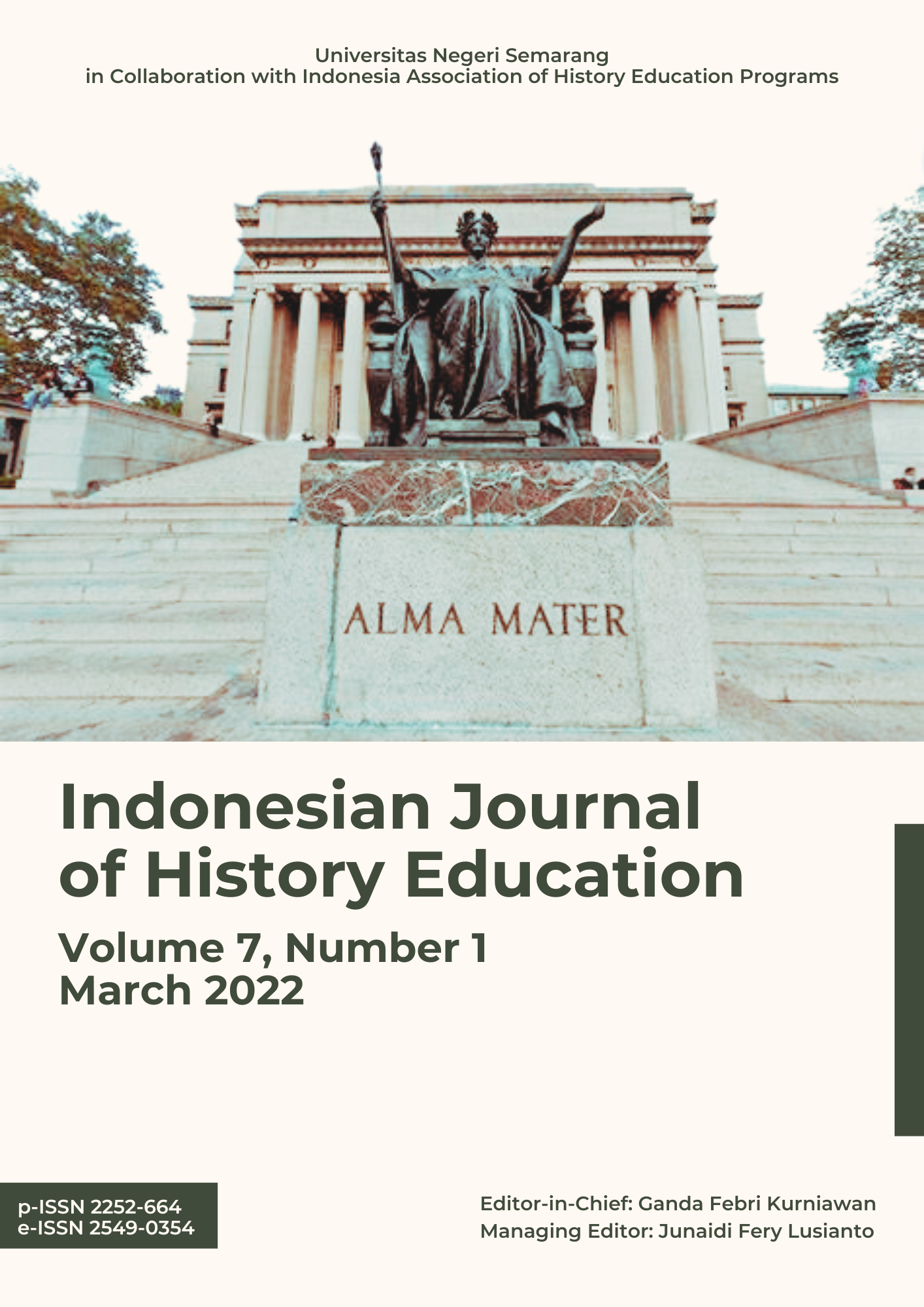Implementation of Affective Assessment in History Learning 2013 Curriculum for Class XI IPS at SMA Negeri 3 Temanggung
Abstract
The research problems in this study are exploring the history teacher in SMA Negeri 3 Temanggung understanding of affective assessment, examining the implementation of affective assessment by History teacher in SMA Negeri 3 Temanggung, studying problems in the implementation of affective assessment in SMA Negeri 3 Temanggung for History subject. The research employed a descriptive qualitative research method. The interviewees are a History teacher for XI social science class, the vice principal for curriculum, and some XI social sciences graders from SMA Negeri 3 Temanggung—the data collection technique employed observation, interview, and documental study. The validity test is done through source and technique triangulation. Based on the study, it is understood that history teachers' understanding of authentic assessment could be higher. This is proven by the dissents in understanding the definition of authentic assessment, the characteristics, assessment forms, assessment techniques and instruments, and the objective of the authentic assessment. The authentic assessment implementation has yet to be adjusted with the lesson plan, for some practical assessment forms, such as peer assessment, have yet to be implemented. The obstacle in assessing history teachers in SMA Negeri 3 Temanggung is that the 2013 curriculum affective assessment needs to be simplified.
References
Aman. (2011). Model Evaluasi Pembelajaran Sejarah. Yogyakarta: Ombak.
Anis, M. Z. A., Susanto, H., & Fathurrahman, F. (2021). Studi Evaluatif Pembelajaran Sejarah Daring Pada Masa Pandemi Covid-19. Fajar Historia: Jurnal Ilmu Sejarah dan Pendidikan, 5(1), 60-69.
Calista, W. (2019). Pelaksanaan Penilaian Autentik Kurikulum 2013 Pada Pembelajaran Tematik Tema Sumber Energi Kelas III Di MI Negeri 1 Yogyakarta. MODELING: Jurnal Program Studi PGMI, 6(2), 196-203.
Creswell. (2014). Penelitian Kualitatif & Desain Riset.Yogyakarta: Pustaka Pelajar.
Efendi, I., Prawitasari, M., & Susanto, H. (2021). Implementasi Penilaian Pembelajaran Pada Kurikulum 2013 Mata Pelajaran Sejarah. Prabayaksa: Journal of History Education, 1(1), 21-25.
Fadlillah. (2014). Implementasi Kurikulum 2013 dalam Pembelajaran SD/MI, SMP/MTs & SMA/MA. Yogyakarta: ArRuzz Media.
Imtihan, E. I. D. Z. N. (2017). Analisis problematika penilaian afektif peserta didik madrasah aliyah. Schemata: Jurnal Pasca Sarjana IAIN Mataram, 6(1), 63-80.
Imtihan, E. I. D. Z. N. (2017). Analisis problematika penilaian afektif peserta didik madrasah aliyah. Schemata: Jurnal Pasca Sarjana IAIN Mataram, 6(1), 63-80.
Kasmadi, H. (1996). Model-Model dalam Pengajaran Sejarah. Semarang: IKIP Semarang Press. Kunandar. (2015). Penilaian Authentic. Jakarta: Rajawali Pers.
Kusumawati, T. (2014). Pengembangan Instrumen Penilaian Afektif Mata Pelajaran Aqidah Akhlak. Journal of Research and Educational Research Evaluation, 3(1).
Moleong, L. J. (2002). Metodologi Penelitian Kualitatif. Bandung: Remaja Rosdakarya. Pramono, S. E. (2014). Kinerja Guru Sejarah: Studi Kausal Pada Guru-Guru Sejarah SMA di Kota Semarang. Dalam jurnal Paramita Vol. 24, p. 1 - Januari 2014.
Nugraheni, M. M., Sutopo, A., & Fuadi, D. (2021). Penilaian afektif dalam pembelajaran tematik masa pandemi Covid-19 di sekolah dasar. ELSE (Elementary School Education Journal): Jurnal Pendidikan dan Pembelajaran Sekolah Dasar, 5(2), 210-218.
Riscaputantri, A., & Wening, S. (2018). Pengembangan instrumen penilaian afektif siswa kelas IV sekolah dasar di Kabupaten Klaten. Jurnal Penelitian Dan Evaluasi Pendidikan, 22(2), 231-242.
Saftari, M., & Fajriah, N. (2019). Penilaian ranah afektif dalam bentuk penilaian skala sikap untuk menilai hasil belajar. Edutainment, 7(1), 71-81.
Sahlan, A dan Angga T. (2012). Desain Pembelajaran Berbasis Pendidikan Karakter. Yogyakarta: Ar Ruzz Media.
Sayono, J. (2013). Pembelajaran Sejarah Di Sekolah: Dari Pragmatis Ke Idealis. Dalam Jurnal Sejarah dan Budaya, Vol VII, No. 1- Tahun 2013, pp. 9-17.
Setiadi, H. (2016). Pelaksanaan penilaian pada Kurikulum 2013. Jurnal penelitian dan evaluasi pendidikan, 20(2), 166-178.
Sukanti. (2011). Penilaian Afektif Dalam Pembelajaran Akuntansi. Dalam Jurnal Pendidikan Akuntansi Indonesia, Vol. IX, No. 1 –Tahun 2011, pp. 74 -82.
Suryadi, A. (2012). Pembelajaran Sejarah dan Problematikanya.Dalam jurnal Historia Pedagogia Vol. 1, No. 1, Juni 2012.
Tati F, Tuti A. (2016). Kendala Guru Dalam Menerapkan Penilaian Autentik di SD Kabupaten Pidie. Dalam Jurnal Ilmiah Mahasiswa Pendidikan Guru Sekolah Dasar FKIP Unsyiah Vol. 1, No 1- Tahun 2016 pp. 147-157.
Tausih, T. U. (2021). Efektivitas pelaksanaan penilaian ranah afektif menggunakan google form saat pembelajaran daring pada Mata Pelajaran PAI SMKN 2 Magetan tahun pelajaran 2020/2021 (Doctoral dissertation, Universitas Islam Negeri Maulana Malik Ibrahim).
Utomo, C. B. (2010). Implementasi TQM Berorientasi Hard Skill dan Soft Skill dalam Pembelajaran Sejarah SMA di Kota Semarang. Dalam Jurnal Paramita. Vol. 20, p. 1.
Wildan, W. (2017). Pelaksanaan penilaian autentik aspek pengetahuan, sikap dan keterampilan di sekolah atau madrasah. Jurnal Tatsqif, 15(2), 131-153.
Yunita, L., Agung, S., & Noviyanti, Y. (2017, May). Penerapan Instrumen Penilaian Ranah Afektif Siswa Pada Praktikum Kimia di Sekolah. In Prosiding Seminar Nasional Pendidikan FKIP (Vol. 1, No. 2).
Copyright (c) 2022 Indonesian Journal of History Education

This work is licensed under a Creative Commons Attribution 4.0 International License.
Copyright Notice
An author who publishes in the Jurnal Indonesian Journal of History Education agrees to the following terms:
- Author retains the copyright and grants the journal the right of first publication of the work simultaneously licensed under the Creative Commons Attribution-ShareAlike 4.0 License that allows others to share the work with an acknowledgement of the work's authorship and initial publication in this journal
- Author is able to enter into separate, additional contractual arrangements for the non-exclusive distribution of the journal's published version of the work (e.g., post it to an institutional repository or publish it in a book) with the acknowledgement of its initial publication in this journal.
- Author is permitted and encouraged to post his/her work online (e.g., in institutional repositories or on their website) prior to and during the submission process, as it can lead to productive exchanges, as well as earlier and greater citation of the published work (See The Effect of Open Access).
Read more about the Creative Commons Attribution-ShareAlike 4.0 Licence here: https://creativecommons.org/licenses/by-sa/4.0/.




